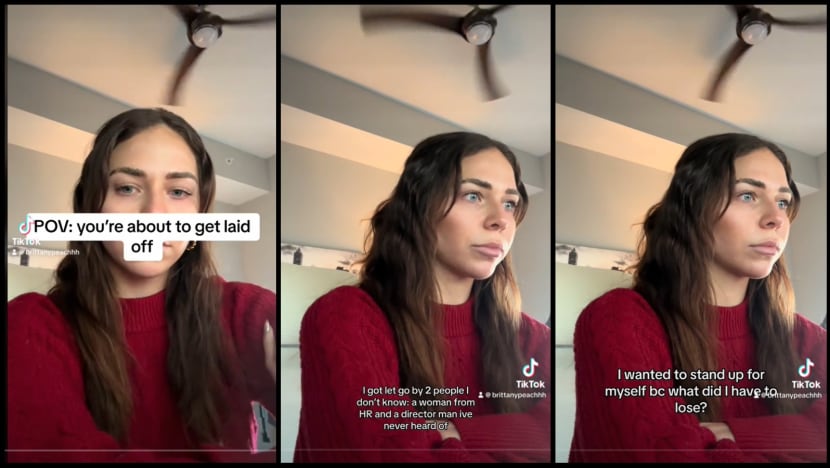Commentary: Sorry you were fired but putting it on TikTok won’t change anything
A clip of an employee getting fired from Cloudflare has gone viral, but videos aren’t always an objective record of what really happened, says Sarah Green Carmichael for Bloomberg Opinion.


This audio is generated by an AI tool.
BOSTON: Viral videos don’t usually last nearly 10 minutes. They don’t usually spawn a weeklong conversation.
But a video an employee at Cloudflare recorded of being fired from her sales job clocks in at 9 minutes, 15 seconds. It has been viewed more than a million times on her TikTok account - and has been shared, remixed and endlessly analysed since it was posted several days ago.
Its popularity is due not only to a prurient interest in watching someone suffer - there are countless videos of human suffering online. And it’s not just because of morbid curiosity about what it’s like to get fired. There are other videos of that, too.
The lack of context about the employee’s situation has allowed the video to become a blank canvas on which viewers can project their own sympathies and judgments.
Only the employee is visible in the video, but we hear her back-and-forth with two HR representatives as they deliver the news and try to deflect her confusion and frustration. But without the full story, we’re left wondering what really happened.
Is this the case of a clueless employee who ignored the warning signs? Or was her new employer uninterested in supporting its new hires? Or just terrible at communicating?
STANDARD, IF NOT STELLAR BUSINESS PRACTICES
Some viewers look at the video and see standard if not exactly stellar business practices. Hire a bunch of 20-somethings and see who sinks and who swims - churn and burn. Grade employees on a forced curve and fire the bottom 10 per cent - rank and yank.
Outsource the dirty work to people with little or no connection to the employee being terminated. It’s not personal; it’s just business. This is how big companies work.
That’s the message Cloudflare CEO Matthew Prince seemed to lean on in his response on X (formerly Twitter). Although he called the video “painful to watch”, he also defended his company, saying: “We fired around 40 sales people out of over 1,500 in our go to market org. That’s a normal quarter ... Sadly, we don’t hire perfectly.”
Others assume that the fired worker must have done something to warrant being let go. By uploading the video, they say, she showed herself to be a loose cannon. They generally empathise more with the HR people doing the firing - terminating employees is never fun, and now their private conversation has been recorded and broadcast without their consent.
A combination of workplace norms and new technologies - sensitive conversations occurring over Zoom, an employee’s phone camera always within arm’s reach - increases the likelihood that all sorts of private conversations end up online.
That was already the case with texts and emails, which can easily be leaked or hacked to the embarrassment of all involved. And I’ve heard stories from the pre-internet era of managers slowly realising their disgruntled employee was most likely recording the conversation on a cassette tape. But a video makes it all so much more vivid.
And we live in a world with more than a billion surveillance cameras and 6 billion smartphones, each equipped with its own lens. It’s an ad hoc panopticon.
CONSTANT MONITORING TAKES A TOLL
The proliferation of DIY videographers makes it harder for companies to control their image. It makes it tougher for managers to have candid conversations - because the prospect of being filmed tends to encourage the use of a script. And as executives and managers fear they’re losing control, they’ll crack down, putting more pressure on the people rebelling against them: The employees.
Workers are already surveilled - their keystrokes recorded, their idle time logged, their badge swipes and outputs tallied up.
The constant monitoring takes a toll, with professors Michel Anteby and Curtis Chan finding that when Transportation Security Administration agents were watched by supervisors on closed-circuit television, they felt both constantly seen and, paradoxically, never noticed - never appreciated.
The goal of all this filming and uploading is to create an objective record of what “really happened”. But we are not neutral observers. Just think of all the hotly contested videos of police officers, who have long used dashcams and bodycams.
Studies show such clips get judged according to viewers’ existing biases. How much you’re disgusted by Donald Trump’s 2005 “locker room talk” video is probably contingent on how much you want him to be president.
Videos might seem like a way to level the playing field of power, but that’s an illusion. It’s tempting to think that she who holds the camera holds the cards. But these days, we all take turns holding the camera.

















